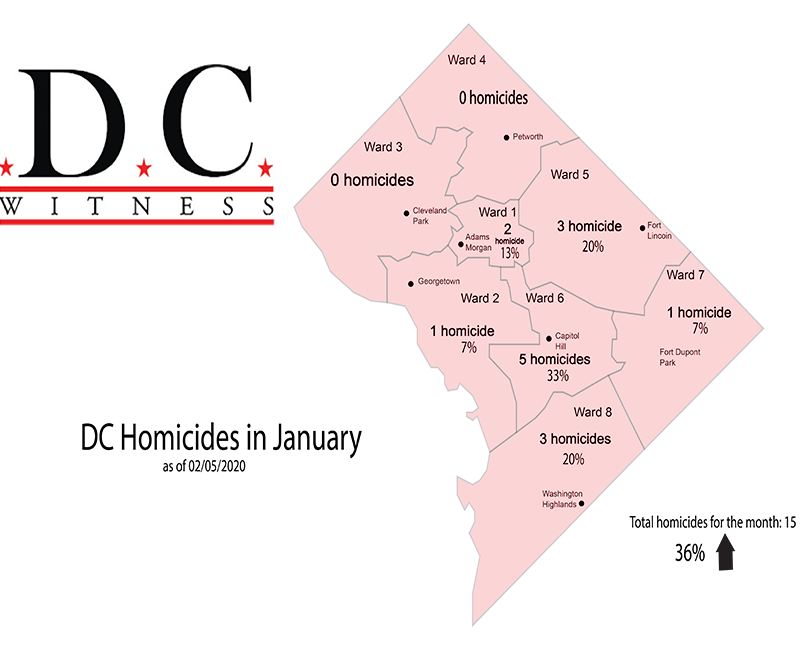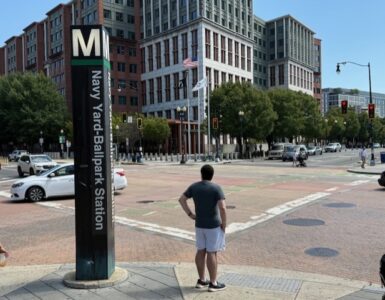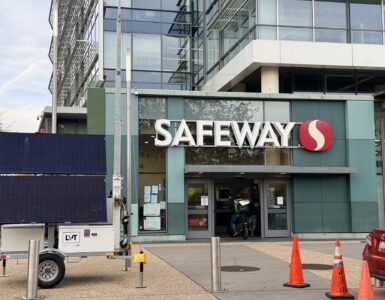Back-to-back shootings on Oct. 2 and Oct. 4 in the Southwest Waterfront and Navy Yard neighborhoods have put a renewed focus on gun violence in Ward 6.
According to data from D.C. Witness, a non-profit that tracks cases of homicide, domestic violence, and sexual assault as they move through D.C.’s Superior Court, an estimated 98 reported cases of homicide have been recorded between the years of 2008 and 2021 in the Navy Yard and Southwest Waterfront neighborhoods, both part of Ward 6.
While Wards 7 and 8 have consistently remained the wards with the highest rates of homicide, Ward 6 has begun to see a noticeable increase in reported cases.
Experts tracking cases and studying the rise of gun-related incidents over the last decade attribute the steady increase in homicide to the unsafe environments and systemic inequality in neighborhoods, and the COVID-19 pandemic creating a shared feeling of isolation,
According to the Metropolitan Police Department’s Newsroom, on Oct. 2, police officers responded to gunshots near Half Street in the Southwest neighborhood.
Police found two men and one woman suffering from gunshot wounds. One man, Garry Stanley, Sr., 44, died from his wounds while the woman was transported to a nearby hospital and the other man was treated on the scene.
That shooting was followed by another two days later on Oct. 4, when police responded to a man found with non-life-threatening injuries on 1st and P Streets SW.
The two shootings come months after three other people were wounded in a high-profile shooting in July outside Nationals Park in Navy Yard that sent players and attendees fleeing the stadium.
LaTrina Antoine, editor-in-chief of D.C. Witness, links the rising tide of gun-related violence in the neighborhood to gun culture in the District.
“Even though D.C. has strict gun laws and technically it’s very hard to have a gun legally in the city, there’s still a lot of guns that are here,” Antoine said.
She said the gun culture is largely associated with illegal guns and individuals who are carrying them because “they don’t believe they could be protected without having a gun.”
The large influx of guns in the area is partly the reason why there have been so many shootings since the organization began tracking cases in 2015, she said.
The data
According to various reports from D.C. Witness, cases of homicide in Ward 6 alone have increased noticeably since 2020.
In January 2020 alone, a total of 15 homicides were reported in the District, with one-third of them occurring in Ward 6.

According to the organization’s Data Explorer, which provides a breakdown of filtered data it collects, crimes involving shootings in Ward 6 spiked the highest in 2020.
Common trends
María B. Vélez, Ph.D., an associate professor in the Department of Criminology and Criminal Justice at the University of Maryland, said the trends she’s seeing in her research reflect higher levels of homicide in Black and Latino communities than in white communities.
Vélez’ said her research has shown the main contributing factor to the disproportionate amount of violence stems from the “dramatic economic inequality that differentiates white communities from black communities or Latino communities.”
Richard Bennett, a professor at American University’s Department of Justice, Law, and Criminology, believes the uptick in homicides over the past few years can be attributed to several factors including frustration, aggression, lack of opportunity in the community and fights over income.
But Bennett said the feelings of isolation created by the COVID-19 pandemic played a pivotal role over the past year.
“Now people are starting to move around again,” Bennett said. “They’re getting out of their houses, they’re getting more into fights, into altercations that lead to gunfire.”
Bennett said the change in the economy with many people out of their minimum wage jobs and unable to access relief funds have caused a spike in disadvantage within the area, which has fueled tension.
“Isolation has increased tension in the communities and homicides in a lot of cases are related to tension in communities,” Bennett said.
While homicides traditionally take place in “structurally disadvantaged communities,” Bennett said the neighborhood of Navy Yard is interesting as “it’s become incredibly gentrified.”
“On one block you have townhomes that have been renovated and just in beautiful shape, and then on the next block you have some really disadvantaged areas,” Bennett said.
Given the area’s multi-billion dollar redevelopment into a residential and business hub, Bennett said the shootings are most likely occurring in disadvantaged sections that have yet to be renovated or in some parts of renovated areas because that’s where the altercation began.
Combating the problem
LaTrina Antoine of D.C. Witness said the current initiatives the District has in place are not enough to combat the ongoing problem, saying that many are only a short-term fix.
Antoine said the best way to combat the rising tide of homicides is a strategic data-based plan that fixes problems in the long term and prevents the spread of violent crime from seeping into other wards.
Richard Bennett, a professor at American University, said the main way to combat the ongoing gun problem in D.C. is to get rid of guns entirely. However, he said he sees this as a problem given the Supreme Court case Heller v The District of Columbia.
According to the court case, an individual has the right to keep and bear arms but is restricted to in-house possession.
But Bennett said a pending Supreme Court case could eventually play a role in controlling the number of guns in the street.
The case, New York State Rifle and Pistol Association v. Bruen, pertains to a specific law in New York that will examine the word “can” with regards to weapon possession outside of the home.
Bennett also said another way to combat the gun problem in D.C. is to create a safer environment for the young adults and kids who believe they need guns in the first place.
“You need to have more opportunity,” Bennet said.
“Or you need to make it so that the kid doesn’t feel they have to carry a firearm in order to make it to school and make it back home again in the afternoon.”















Add comment